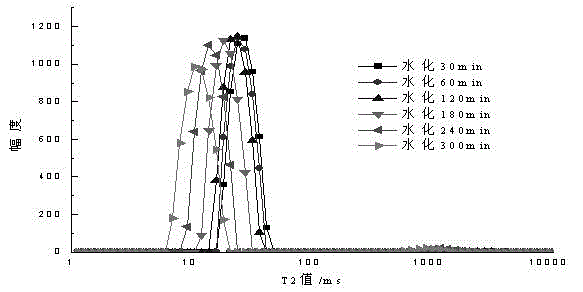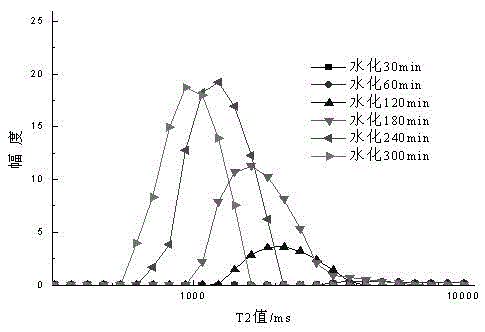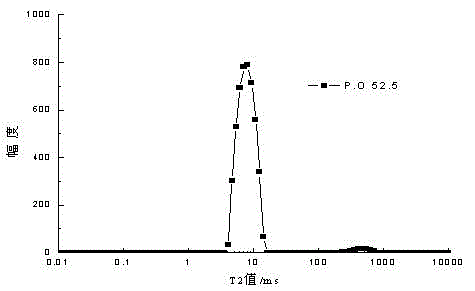Method for measuring bleeding property of cement paste employing hydrogen proton low-field nuclear magnetic resonance technique
A low-field nuclear magnetic resonance and cement slurry technology, applied in the field of building materials, can solve the problems of impermeability, frost resistance and corrosion resistance, the actual water-cement ratio of fresh concrete, the actual volume and the adverse effects of volume stability, weak layer The problem of uneven quality, to achieve the effect of accurate detection
- Summary
- Abstract
- Description
- Claims
- Application Information
AI Technical Summary
Problems solved by technology
Method used
Image
Examples
Embodiment 1
[0040] Test material: cement is P.O 52.5 grade, specific surface area is 396.5 kg / m 3 , the water consumption for the standard consistency is 141g, the initial setting is 1h20min, the final setting is 3h42min, the water-cement ratio used for the example test is 0.5, the expansion loss is 32% in 120min, and 67% in 300min. The test equipment and parameters are: MICRO-MR20 nuclear magnetic resonance analyzer is used for the test, CPMG pulse sequence is used, the number of echoes is n=18000, the echo time is 2τ=100μs, each CPMG signal scans m=8 times on average, and Repeat decay. The resampling waiting time TW is 18000ms. According to the calculation method mentioned above, the bleeding coefficient can be obtained.
[0041] figure 1 and figure 2 T is the cement paste with different hydration time 2 distribution and T representing the bleeding peak 2 curve.
[0042] Substitute the data in the figure into the calculation formula (2) to obtain the bleeding coefficient of the ...
Embodiment 2
[0046] Test material: cement is P.O 52.5 grade, specific surface area is 396 m 3 / kg, the water consumption of the standard consistency is 141g, the experiment controls the fluidity (200mm±5mm), adjusts the water-cement ratio of the slurry for the bleeding test, and the water-cement ratio of the slurry for the bleeding test is 0.44. The nuclear magnetic resonance test equipment and parameters are: MICRO-MR20 nuclear magnetic resonance analyzer is used for the test, CPMG pulse sequence is used, the number of echoes is n=18000, the echo time is 2τ=100μs, and each CPMG signal scans m=8 times on average , and repeated decay. The resampling waiting time TW is 18000ms. Will image 3 The data in is calculated by formula (2) to get the bleeding coefficient K was 1.65%. Test the bleeding rate according to JC / T 2153-2012 "Test Method for Bleeding of Cement" to get the bleeding rate B w was 1.61%.
Embodiment 3
[0048] Test material: cement is P.O 32.5 grade, specific surface area is 384 m 3 / kg, the water consumption of the standard consistency is 113g, the experiment controls the fluidity (200mm±5mm), adjusts the water-cement ratio of the slurry for the bleeding test, and the water-cement ratio of the slurry for the bleeding test is 0.41. The nuclear magnetic resonance test equipment and parameters are: MICRO-MR20 nuclear magnetic resonance analyzer is used for the test, CPMG pulse sequence is used, the number of echoes is n=18000, the echo time is 2τ=100μs, and each CPMG signal scans m=8 times on average , and repeated decay. The resampling waiting time TW is 18000ms. Will Figure 4 The data in is calculated by formula (2) to get the bleeding coefficient K 2.25%. Test the bleeding rate according to JC / T 2153-2012 "Test Method for Bleeding of Cement" to get the bleeding rate B w was 2.18%.
PUM
| Property | Measurement | Unit |
|---|---|---|
| bleeding rate | aaaaa | aaaaa |
| bleeding rate | aaaaa | aaaaa |
Abstract
Description
Claims
Application Information
 Login to View More
Login to View More - R&D
- Intellectual Property
- Life Sciences
- Materials
- Tech Scout
- Unparalleled Data Quality
- Higher Quality Content
- 60% Fewer Hallucinations
Browse by: Latest US Patents, China's latest patents, Technical Efficacy Thesaurus, Application Domain, Technology Topic, Popular Technical Reports.
© 2025 PatSnap. All rights reserved.Legal|Privacy policy|Modern Slavery Act Transparency Statement|Sitemap|About US| Contact US: help@patsnap.com



